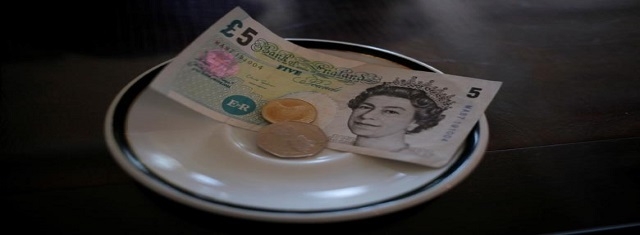News
Worst four days since June pushes sterling to $1.22
FOREIGN EXCHANGE ANALYSIS

An English five Pound note and coins
USPA NEWS -
Sterling shed more then 1 percent to trade as low as $1.22 on Tuesday as senior officials and investors pointed to the potential for more declines in a market still trying to recover from Friday's 10 percent flash crash.
The past four days were the pound's worst since the aftermath of the vote to leave the European Union in June, and Bank of England policymaker Michael Saunders warned a "bumpy" Brexit could sharply reduce British economic growth.
"Given the scale and persistence of the UK's current account deficit, I would not be surprised if sterling falls further, but I am fairly agnostic as to whether any further depreciation is likely," Saunders told lawmakers in a written submission.
Like other Bank of England officials, he also sounded sanguine on how the bank would react to further declines in the pound, saying it was likely to look through any impact on inflation. Former Governor Mervyn King told Sky News on Monday that the fall in the pound.
"Given the scale and persistence of the UK's current account deficit, I would not be surprised if sterling falls further, but I am fairly agnostic as to whether any further depreciation is likely," Saunders told lawmakers in a written submission.
Like other Bank of England officials, he also sounded sanguine on how the bank would react to further declines in the pound, saying it was likely to look through any impact on inflation. Former Governor Mervyn King told Sky News on Monday that the fall in the pound.
Traders said it was the conviction that the government is headed for a "hard Brexit" in which Britain leaves the EU single market that was keeping investors away.
The pound traded as low as $1.2200, according to Reuters data, down 1.3 percent on the day, and also traded weaker against the euro at 90.66 pence. All of that dragged trade-weighted sterling index to its lowest since early 2009, data from the BoE showed.
"We still see further downside risk to sterling, particularly versus the dollar, but we are very conscious that this will not be a straight-line move in the currency," said Thushka Maharaj, global strategist at JPMorgan Asset Management.
The pound traded as low as $1.2200, according to Reuters data, down 1.3 percent on the day, and also traded weaker against the euro at 90.66 pence. All of that dragged trade-weighted sterling index to its lowest since early 2009, data from the BoE showed.
"We still see further downside risk to sterling, particularly versus the dollar, but we are very conscious that this will not be a straight-line move in the currency," said Thushka Maharaj, global strategist at JPMorgan Asset Management.
"With reasonably strong recent economic data but a weaker long-term outlook picture, markets are expecting the BoE will now hold off on any further rate cuts this year."
They remained negative towards the currency over the long term while positioning for a short-term bounce, he added.
Norway's sovereign wealth fund, the world's largest and a major owner of British shares and government bonds, told Reuters that Friday's flash crash was a correct move that reflected the expectations for Britain's economy.
The major banks have stuck to forecasts of around $1.20-1.25 for sterling, but Friday's apparently computer-trader-driven 10-minute slide to a 31-year low of $1.1491 has some wondering if a drop closer towards parity is likely.
They remained negative towards the currency over the long term while positioning for a short-term bounce, he added.
Norway's sovereign wealth fund, the world's largest and a major owner of British shares and government bonds, told Reuters that Friday's flash crash was a correct move that reflected the expectations for Britain's economy.
The major banks have stuck to forecasts of around $1.20-1.25 for sterling, but Friday's apparently computer-trader-driven 10-minute slide to a 31-year low of $1.1491 has some wondering if a drop closer towards parity is likely.
They wonder if Britain can continue to draw in the large net flows of capital it needs to fund its current account gap, equivalent to 6 percent of gross domestic product, if the economy suffers a downturn and companies relocate to Europe.
If it cannot, the pound may need to fall much further to slow imports and improve the competitiveness of exporters.
Worried by the outlook for capital flows, Deutsche Bank strategist George Saravelos has been predicting a drop in sterling to $1.15 since last year, and he said the pound might now get there faster.
"If you look at yesterday or the day before, it can go very quickly now," he said. "The basis for our forecast was the very bad flow picture in the UK, even without Brexit."
If it cannot, the pound may need to fall much further to slow imports and improve the competitiveness of exporters.
Worried by the outlook for capital flows, Deutsche Bank strategist George Saravelos has been predicting a drop in sterling to $1.15 since last year, and he said the pound might now get there faster.
"If you look at yesterday or the day before, it can go very quickly now," he said. "The basis for our forecast was the very bad flow picture in the UK, even without Brexit."
Liability for this article lies with the author, who also holds the copyright. Editorial content from USPA may be quoted on other websites as long as the quote comprises no more than 5% of the entire text, is marked as such and the source is named (via hyperlink).





